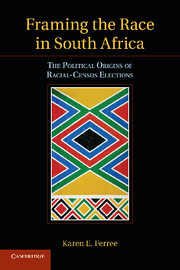Book contents
- Frontmatter
- Contents
- List of Tables
- Acknowledgments
- 1 Introduction
- 2 Voters
- 3 The 1994 Campaigns
- 4 The 1999 Campaigns
- 5 The 2004 Campaigns
- 6 Can a Leopard Change Its Spots? Candidate Demographics and Party Label Change
- 7 Why So Slow? The Political Challenges of Candidate Transformation for Opposition Parties
- 8 Negative Framing Strategies and African Opposition Parties
- 9 Conclusion: South Africa in Comparative Perspective
- References
- Index
- Titles in the series
6 - Can a Leopard Change Its Spots? Candidate Demographics and Party Label Change
Published online by Cambridge University Press: 06 December 2010
- Frontmatter
- Contents
- List of Tables
- Acknowledgments
- 1 Introduction
- 2 Voters
- 3 The 1994 Campaigns
- 4 The 1999 Campaigns
- 5 The 2004 Campaigns
- 6 Can a Leopard Change Its Spots? Candidate Demographics and Party Label Change
- 7 Why So Slow? The Political Challenges of Candidate Transformation for Opposition Parties
- 8 Negative Framing Strategies and African Opposition Parties
- 9 Conclusion: South Africa in Comparative Perspective
- References
- Index
- Titles in the series
Summary
The previous three chapters showed the many challenges South African opposition parties have faced in trying to use campaigns to alter party images. I now turn to an alternative method that parties have pursued toward this end: the manipulation of candidate characteristics. I argue that where the ideological reputations of parties are not well developed, candidate characteristics figure prominently in the formation of party labels. Changing candidate characteristics therefore offers parties a means to alter their party labels. This works through two mechanisms. First, a preference effect: Changing the decision makers in the party alters beliefs about the outcomes the party is likely to pursue. And second, a signaling effect: By unseating party stalwarts in favor of candidates with a different set of characteristics, a party sends a potent signal about its intentions.
I test these intuitions in the South African context. I show that parties (as well as journalists, pundits, and academics) frequently discuss the racial balance of candidate lists. Information about the racial balance of lists is therefore common knowledge and widely believed to be important. Using a new dataset that tracks the changing racial balance of the candidates of the ANC, the NNP, and the DA, I then demonstrate that the parties with the strongest incentives to change their labels – the “white” opposition parties – have indeed made extensive changes to their profiles since the end of apartheid. Starting out as exclusively white, these parties were at least 30 percent African by 2004.
- Type
- Chapter
- Information
- Framing the Race in South AfricaThe Political Origins of Racial Census Elections, pp. 141 - 162Publisher: Cambridge University PressPrint publication year: 2010

